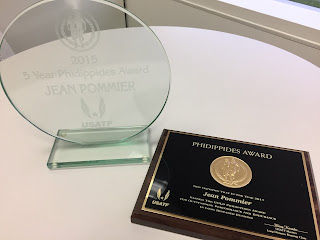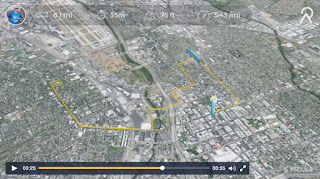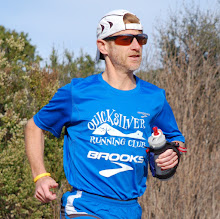Disclaimer: this post is an open letter aimed at the current and potential participants of our Pacific Association MUT Grand Prix. But everyone is welcome to read to understand what this competition is about, although I then recommend reading my 2016 post about the
Anatomy of an Ultra Grand Prix, before. Well, if you are dead serious about ultra running...! ;-)
1. Background
Yes, this local ultra tradition has been on for 25 years, it all started in 1992, with the awards being added in 1996 and the first banquet in 1997. Although our sport was much smaller and confidential back then, I'm told the passion was amazing and we owe a lot to the catalyst role which BAUR (Bay Area Ultra Runners) has played through this quarter of century. There is a book to be written about BAUR, and I'll likely do at least a post on it based on the information I already collected, for now one name is enough to capture the imagination, our local legend Dick Collins!
A huge thank you to BAUR for all they did and still do for our local ultra running community!
Fast forward 25 years then and it is time to unveil the 2018 schedule. Rather than just posting it, I wanted to share some of the background and process which led to it and a few key decisions.
2. People
Before we even talk about process, let's start with the people topic. First and foremost, the Grand Prix only exists thanks to YOU, because we have participants into it so, ultra runners are the number 1 force behind it. To participate you need to be a member of the
Pacific Association of USATF (USA Track & Field), in good standing. You don't even have to join a club or a team, but a large part of the fun comes from the team competition so it is highly recommended. The yearly membership is $30, or $25 if you commit for 4 years, and comes with other
benefits such as sport insurance and several discounts on apparel, rental cars, hotels and airlines. And the same membership gives you access to the other Grand Prix of cross-country (XC) and road (short and long), you set the limit! Other benefits include prize money and race entry discounts for top age group winners! Please consider joining then, if not already, or renew (
online form).
Beyond the runners, we do have a
MUT (Mountain Ultra Trail) subcommittee within the LDR (Long Distance Running) committee of our local association. This subcommittee has been chaired by Hollis Lenderking for these 25 years with Bill Dodson leading for the past 3 years. They have been assisted by Gary Wang who did the scoring for several decades before Bill took over. Now 82, it seemed fair to let Bill focus on not only his family life but his running: in the past years he broke every ultra running record, both on
the road and
the track, and won all the Grand Prix (XC, Road, Ultra) for his age group, phew!
The transition occurred in September and I'm glad other volunteers stepped up to form our new subcommittee in the following voting and active capacities:
- Scoring: Nakia Baird
- GP Administrator: Denise Williams
- Communication: Verity Breen
- Emeritus Chair: Hollis Lenderking
- Chair: Jean Pommier
Our first goal has been to ensure continuity of course and go through an extensive knowledge transfer. Although it was my 12th participation in the MUT Grand Prix this year, there were so many things I had no idea were happening behind the scene, fascinating! After some initial delay, Nakia has been able to publish the results of the last 3 races, and will now work on the last race of the season, Quad Dipsea. In the meantime, with the big race registrations coming up in December, we had to also work on finalizing the 2018 schedule so you could make the appropriate decisions.
3. Process
Before jumping to the outcome, here are a few elements which led to the selection.
First, we took the opportunity of the transition to conduct an extensive survey which 74 of you completed, almost half the 2017 Grand Prix participants! A big thank to those of you who took the time to go through the 17 questions, that provided a lot of insights on what you like in the GP as well as new expectations. To keep this post short (ahem, shorter...), I'll just summarize the findings with the following paragraphs:
Executive summary
More of the same (classics, multi distance events, races of same types, year-through), but with a few new races, less/no hard-to-get-in ones. Strong emphasis on team competition. Strong interest for additional sub-ultra-trail format. Some exclusive/special treatment for GP participants would be nice.
By the numbers
- GP 2018 intent: 95% yes to maybe
- If on the edge, why: 61% depends on new races, 20% depends on old races
- 19 events, 14 scoring possibilities: 47% about right, 38% a lot, 3% too many, 12% not enough (!)
- GP 2018 direction: 65% new races, 9% the same/classic, 26% either way
- Races of the same format (e.g. 7 x trail 50K): 77% ok, 23% no or less
- Inclusion of hard-to-get-in race: 24% ok, 45% against, 31% either way
- Spread over long period (current 10 months or even a year) : 90% favorable
- Top motivation: points for the team; camaraderie; motivation; goal setting
- Multi-distance events: 62% like them but 28% agree that it makes team scoring harder and 18% that it dilutes the competition
- Scoring availability expectation: from 1 to 2 weeks
- Sub-ultra GP interest: 83% yes/maybe, 17% no
A second element in the process was the commitment which Bill had already made to or gotten from the Race Directors that the 2018 schedule will pretty much be the same as the previous years. For this reason, don't expect too many changes although we have attempted to bring in as much novelty as the no-change constraint could permit. While we were are it, we started looking at more drastic innovations for 2019 and 2020, a key one being a rotation of key races over odd and even years since we are so rich and blessed with quantity of extreme quality races in our Pacific Association region.
Another rationale for more change is to better live by the MUT meaning: when I first joined this Grand Prix, I had the impression that all ultras where on trails and mountainous but that's not what MUT means. MUT is actually a group of three very different sports:
- First, and the easiest one to define, is U for Ultra running, which includes any race longer than a marathon, either on road (which used to be the main terrain for ultras in Europe for many decades), trail or even track (another traditional ground for ultra running purists). And the profile can be flat or hilly.
- M is for Mountain and has a more fuzzy definition (and I'm still learning myself as the international bodies still argue over the criteria): no distance limit but either a super steep uphill, or extreme foot elevation gain and loss if not straight up hill.
- T is for Trail and, like Mountain, doesn't have strict criteria either except that the course has to be a trail, and the distance is typically shorter than a marathon, yet longer than the typical cross country distances. Let's say in the 15-35K range.
As you can see our MUT Grand Prix has been U for 25 years and, given the popularity of trail running, we are going to look at creating a separate Trail Grand Prix, partnering with the dozens of events organized in our area as well. As for M, this is more challenging as you need Alpine terrain and that pretty much limits it to Squaw Valley within our perimeter (think Broken Arrow). What is clear is that, if or when we bring a Trail Grand Prix, we cannot continue having 18 or 20 events in our Ultra Grand Prix, hence the need for additional change for the years to come.
Beyond these considerations, here are additional criteria we have been considering in our selection, and will take into account for the following seasons:
- Classic status (tenure in the Grand Prix);
- Reputation and experience (versus brand new event);
- Balance between the Bay Area and Sacramento/Tahoe areas (to share the travel burden);
- Ease of entry (versus super competitive lotteries or events filling up in minutes);
- Registration fee;
- Support of the local ultra running community;
- Balance between race organizations (clubs or commercial race organizations);
- Qualification credentials for other notable races (e.g. Western States, Hard Rock, UTMB), including the offering of ITRA points which are becoming increasingly important to race abroad;
- Prize money.
Yes, that's a way over-constrained optimization problem and the sophisticated spreadsheet I created doesn't do justice of the subjective decisions we had to make. Also, we looked at a total of 37 events in the process.
4. Finally, the Schedule!
With that, drum roll please, here is what we came up with:
- Jed Smith 50K (the classic season opener to get you legs moving on a safe flat course);
- Fourmidable 50K (a bid for the 50K Trail Nationals, like last year);
- Way Too Cool 50K (the largest 50K trail race in North America and the largest Pacific Association contingent of runners in a single trace race);
- American River 50M (another classic mixing road and trail and finishing in the mythical Auburn);
- Ruth Anderson 50M and 100K (but not the 50K as it was too many events for teams to score, yet these are our only Road 50M and 100K);
- Quicksilver 50K and 100K (two classic races to kick off heat training for the summer ultras);
- SilverState 50M (but not the 50K since we already have so many 50K trail races, including a few in the North East);
- Ohlone 50K (30+ years and another great heat training opportunity, guaranteed!);
- Summer Solstice (our 24-hour event replacing RiverBank One Day which has been cancelled in 2018), with both a 100-mile and 100K scoring option;
- Skyline 50K (one of the oldest trail 50K races in North America, if not the oldest, and a safe course for rookies);
- Tamalpa Headlands 50K (ex National Championships course and 1/3 of the field was from the Pacific Association un 2017);
- Headland Hundred 100M (making great use of the amazing views and hills of Marin Headlands);
- Lake Folsom 100K (addition of a 100K trail in the North East, with this 4th edition);
- Rio Del Lago 100M (the ultimate Western States qualifier which also goes through several times through the capital of endurance sports)
14 events total, including 17 opportunities to score in the individual categories, and, for the large club, (3 categories [Men, Women, Mixed] x 17) = 51 potential scores!!
All this is subject to proper PAUSATF sanctioning of the respective events of course but all Race Directors do have prior experience with the process so that shouldn't be an issue.
If you are curious, here are a few other associated KPIs (Key Performance Indicators), as we say at work.
The pros will immediately spot that, to make room for newer races per the wish of many, we had to make tough decisions to drop a few events, like our predecessors had to do with Western States and Tahoe Rim Trail 100 because of the difficulty to get in, a few years ago. That being said, we still strongly encourage you to enter and run them if you can or prefer these distances, these events are of very high quality and we hope to find ways to get them back, alternatively from year to year at a minimum.
- Most notably, Miwok 100K, which is increasingly hard to get in (lottery), but a Western States qualifier which we hope to re-include in the rotation based on lottery odds;
- Ruth Anderson 50K as noted above;
- Same for SilverState 50K;
- And the legendary Quad Dipsea.
Again, strongly encourage you to still enter Miwok and Quad in addition to competing in the Grand Prix events. If you manage to get in which isn't always the easiest part of running an ultra, nowadays! ;-)
Another clarification, as noted above, is that this doesn't mean the schedule will remain the same in 2019. There are several key drivers to bring more drastic change after a quarter of a century and so much evolution in our sport; some races may come back, some may go. But we'll work at giving more advanced notice than this year, which means we have to have a 2019 schedule by October 2018, phew!
Most of the rules will remain the same although we are considering slight amendments to the scoring system to make the season more exciting, for instance flattening the coefficients between shorter and longer ultras (to avoid the overwhelming impact on 100-milers). Stay tuned!
By the way, our easiest and most efficient way to communicate around this Grand Prix is through our
PA Ultra GP Facebook page, please make sure to request to join if you are on Facebook. Otherwise, I'm sure you can find a buddy within your team to keep you posted; which is one more reason to join the fun of running for a team/club!
Also, please make sure to thank the Race Directors of all these events for the time and energy they are putting into their races (registration, permits, recruiting an army of volunteers, the logistic, ...), as well as the extra administrative burden they have to go through to sanction their races so they can be part of our Grand Prix.
Last minute! We had almost finalized the schedule and were told that the 2 bids for the 50K Trail Nationals will be considered at the Annual USATF Convention on December 2 and 3, for a vote there, but we just learned that these Championships were awarded to New Hampshire instead for 2018, and to Fourmidable in 2019. One more reason to run Fourmidable and Skyline this year to support our local Race Directors! More details about all the Mountain, Ultra and Trail Nationals for 2018 can be found in
this TrailRunner article.
And now, you can finalize your ultra 2018 planning! We certainly hope to see all of you on our amazing Pacific Association trails, between the Coast and Reno, around the Bay Area, the Sacramento Valley or over the Tahoe mountains, bring on the friendly individual and team emulation and competition!
Cheering to your success in the 26th Ultra Grand Prix!































































